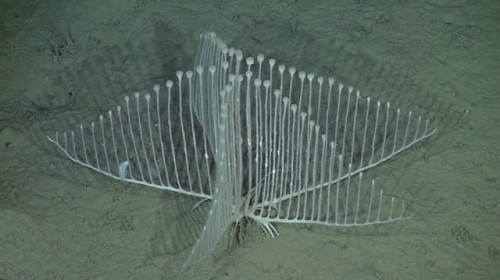
Every few months we see new land/aquatic discoveries in either the deep jungles or the vast seas. Although these finds are often astounding to those who discover them, they are more a distraction from a day of drudgery to the masses.
However, once in a while something comes along that actually gets us interested. Today we have one such example that might catch your eye.
If you didn’t know it already, there are species of carnivorous sponges out there. Notwithstanding is a newly discovered creation that puts all other flesh eating sponges to shame.
Recently a brand new carnivorous sponge was discovered off the coast of California. The (Chondrocladia lyra) “Harp Sponge” is a brand new species and you guessed it, this creature of the deep is shaped like a harp. You know, that fancy musical instrument played by a woman in a flowing gown at uppity events.
Today we have video of this amazing ocean predator as well as some official sciencey commentary:
Extraordinary New Sponge Species Discovered
A team of scientists led by Dr Lonny Lundsten of the Monterey Bay Aquarium Research Institute (MBARI) in Moss Landing, California, has discovered an extraordinary new species of carnivorous sponge.
The new species is named the harp sponge, or Chondrocladia lyra, because its basic structure is shaped like a lyre or harp.
Typically, sponges feed by straining bacteria and bits of organic material from the seawater they filter through their bodies. However, C. lyra is a deep-sea predator.
Harp sponges snare their prey – tiny crustaceans – with barbed hooks that cover the sponge’s branching limbs. Once the harp sponge has its prey in its clutches, it envelops the animal in a thin membrane, and then slowly begins to digest it.
Using MBARI’s remotely operated vehicles, the team collected two sponges and made video observations of ten more. The first harp sponges that they found had only two vanes. However, additional dives revealed sponges with up to six vanes radiating out from the organism’s center. Scientists believe the harp sponge has evolved this elaborate candelabra-like structure in order to increase the surface area it exposes to currents, much like sea fan corals. The findings appear in a paper published in the journal Invertebrate Biology.
It has been less than twenty years since scientists first discovered that sponges could be carnivores. Since then, marine biologists have discovered dozens of new carnivorous species. In fact, all the members of the harp sponge’s family Cladorhizidae are carnivores.
“C. lyra is an extraordinary example of the kind of adaptations that animals must make in order to survive in such a hostile environment.”
OK, it’s not paranormal, nor is it a Bigfoot, but I think it fits right in with our search for crypto stuff. It’s carnivorous, it’s an invertebrate, it looks very strange and…did I mention it’s carnivorous?
Here’s some even more official science commentary:
An extraordinary new carnivorous sponge, Chondrocladia lyra, in the new subgenus Symmetrocladia (Demospongiae, Cladorhizidae), from off of northern California, USA
Welton L. Lee1,*,
Henry M. Reiswig2,3,
William C. Austin4,
Lonny Lundsten5Abstract
Chondrocladia (Symmetrocladia) lyra subgen. nov., sp. nov., is described from northeast Pacific sites at Escanaba Ridge and Monterey Canyon at depths of 3316–3399 m. Two retrieved specimens are described in detail, while variations are described in ten photographed or videotaped specimens. The basic structure, termed a vane, is harp- or lyre-shaped. From 1 to 6 vanes extend by radial growth from the organism’s center. The orientation among the vanes is approximately equiangular, such that together they display pentaradiate, tetraradiate, triradiate, or biradiate symmetries. Each vane is formed by a horizontal stolon supporting a series of upright, equidistantly spaced branches each of which terminates at its apex in a swollen ball in all observed specimens except the paratype. Swellings occur midway along the branches in the holotype, but not in the paratype. A linear row of filaments project from the sides, front, and back of each branch, and also from the tops of each stolon. The terminal balls are the sites of spermatophore production and release; mid-branch swellings are sites of oocyte maturation. The two megasclere spicule types have specific distributions; styles support rhizoids, stolons, and branches, while subtylostyles support filaments and terminal balls. Anchorate isochelae cover all surfaces. Enclosed crustacean prey on branches and stolons provide direct evidence of carnivory. The structure of the vanes maximizes surface area for passive suspension feeding. Increased surface area could also maximize spermatophore capture, with the sigmas projecting from the spermatophore surface being caught by projecting isochelae on filaments. Swellings on filaments are snared spermatophores, firmly fused to recipient tissues and undergoing destruction. Spermatophores on filaments are present in branch swellings containing early and mature oocytes. Oogenesis and maturation occur only in proximity to branch swellings, suggesting that development is induced by spermatophore reception. Symmetrical development of uniserial branched stolons (the vanes) characterized members of the new subgenus Symmetrocladia.
See the full on, stuff you probably wouldn’t understand article here.
Now the only question is, how big can one of these things get? I mean, are we going to have to make up stories about man eating harp sponges soon?
Finally, for those of you who don’t like this kind of thing, don’t you think it’s high time you learned about something that actually exists? No? How about if I told you that this sponge was a distant cousin to Spongebob Squarepants? Yea, now you’re paying attention!
NOTE: Video is the property of Viacom
Thanks to Sci-News and the Wiley Online Library for bringing us this macabre new sponge.
Associated Content:
EX: Invertebrate Biology
EX: The Wonders Of The Sea Sponge
EX: Wiki – Chondrocladia




